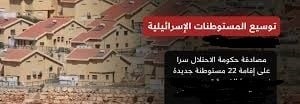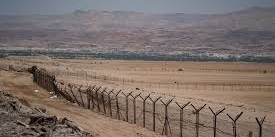By: Madeeha Al-A’raj
The National Bureau for defending land and resisting settlements ( nbprs ) stated in its latest weekly report , that Israeli occupation bulldozers continue working to open bypass roads to reach the Jewish settlement in the West Bank, including Jerusalem, knowing that the main goal of these bypass roads is to destroy and confiscate large areas of Palestinian land in favor of settlement, and On to change the geography, topography and demography of the land through the expansion of its settlement project, and then facilitate building new settlement infrastructures that enable the occupation in the future annex wide areas of West Bank lands.
Within the context comes the function of the new bypass roads, for which the Israeli governments headed by Netanyahu has provided huge budgets exceeding NIS 800 million, as well as budgets that fall under sub-budgets allocated for settlement in a number of ministries, including the so-called Ministry of Security or Defense, such as the Hawara bypass road towards the Za’tara Junction with a length of approximately 7 km to connect the settlements surrounding the city of Nablus with road n 60, which leads to the center of Tel Aviv and Jerusalem, and the Al-Aroub bypass road from the junction of the Gush Etzion settlement to the south of Bethlehem and extending to Komi Tzur north of Hebron to connect the settlement bloc in the Hebron city with its 60 bypass road, and providing security for settlers to move without approaching Palestinian urban areas, in addition to the Qalandia Tunnel, the Al-Lubban Al-Gharbia bypass road, the Nabi Elias bypass road in Qalqilya Governorate was completed, and the Eastern Ring Road, which extends from the area near the Har Homa settlement (Abu Ghneim) southeast of Jerusalem to a bridge that passes in the area of Sur Baher and then to the Al-Zaeem area, known as the “American Street”, and other ways, for which the Israeli occupation uses great resources to serve its judaizing and expansionist settlement project at the expense of the lands and interests of Palestinian citizens.
This was Netanyahu’s policy, and it does not seem that his successor, Bennett’s policy differs from that, but more extreme. Bennett is not in his program to annex swathes of the West Bank to the occupying power, after the international scene changed with the departure of Donald Trump and the arrival of Joe Yeiden to power in the White House, the Bennett government is proceeding with the same policy based on settlement expansion and the policy of imposing new facts on the ground, and this was clear in his statements about settlement expansion after his meeting with the heads of settlement councils in the West Bank for the first time since he entered office. He will stop settlement expansion and will study the requests they have submitted for more settlement construction.
Bennett’s office said that he discussed “issues related to the development of settlements in the West Bank and the strengthening of local authorities in the area, and that it was agreed” to continue joint work to advance these issues. Since entering office, Naftali Bennett has repeated statements related to “reducing the conflict” and not resolving it.
He said during a lengthy interview with The New York Times, last month, that he will not conduct any negotiations with the Palestinian Authority, and that he opposes the establishment of a Palestinian state, and stressed that his government will continue to expand the settlement project in the West Bank. It seems clear that his government is moving to push for new settlement plans during the coming period, under the pretext of “natural growth” of settlers in the West Bank, in addition to pushing new bypass road projects and approving more settlement construction in Area C under the same pretext. Last week, settler leaders in the West Bank organized a protest in front of the Israeli Prime Minister’s office in Jerusalem, to protest what they described as “drying up construction in settlements.”
On the other hand, the occupation municipality in occupied Jerusalem started replace the names of streets in the Old City with Hebrew names and dyeing them with biblical connotations. The occupation municipality changed the Umayyad palaces road adjacent to the southern Al-Aqsa Wall, Silwan Road, to “Shir Hama’alot,” in addition to changing the names of alleys and streets in the town of Silwan to Talmudic and biblical ones and with the names of Jewish rabbis.
In Jerusalem, the “temple organizations” escalated their Judaization demands in conjunction with the coming of the Jewish holidays, as the “temple groups” incited settlers to storm Al-Aqsa Mosque, during the so-called “days of repentance,” which are the 10 days extending from the Hebrew New Year until Yom Kippur, under the slogan “Breathe and do not be afraid, for the police are protecting the Temple Mount.” And it announced its cooperation with the occupation police, to provide the necessary protection for the intruders, and also called on the Israeli PM to allow it to blow the Jewish trumpet “shofar” inside Al-Aqsa Mosque, in an attempt to implement more Jewish rituals inside it.
List of Israeli Assaults over the Last Week Documented by the National Bureau:
Jerusalem:
- Forcing a Jerusalemite to demolish parts of his own house in the Beit Hanina town under the pretext of not having a building permit, fined him NIS 9,000 in 2020. Another demolished his house to avoid paying high demolition costs.
- Forcing the Dweik’s family to demolish their own house in the Al-Bustan neighborhood in Silwan town.
- Demolishing a memorial to the Jordanian and Arab martyrs in the 1967 war in the Yusfiya Cemetery, in preparation for turning parts of the cemetery into a biblical garden.
- Seizing a bulldozer in Beit Iksa, northwest of occupied Jerusalem, under the pretext of working on agricultural land near the “Ramot” settlement built on the village lands.
- The Silwan Land Defense Committee confirmed on the 5th of September that six neighborhoods with about 6,800 homes in the town are threatened with complete demolition in favor of the settlement expansion in the occupied city.
Hebron:
- Damaging the tires of a tanker belonging to the citizen Jihad Ibrahim, to prevent the water from reaching the residents of the Birin area in an attempt to expel the residents from the area in favor of settlements.
- Closing all the corridors and courtyards of the Ibrahimi Mosque in the city of Hebron under pretext of securing the settlers’ celebration of the “Hebrew New Year’s Day”. On the other hand, a group of Israeli settlers from “Kiryat Arba” destroyed the vehicles of citizens in the Jaber neighborhood, and attacked their homes and properties.
Bethlehem:
- Noitifying of uprooting the grape trees that were planted five years ago in the “Al-Qusayr” area, northeast of Battir, under the pretext of being under Israeli sovereignty.
- Storming the two areas of Khirbet Ayesh in the village of Artas, and the outskirts of the third pond in the Solomon’s Pools, south of Bethlehem.
Nablus:
- Demolishing all roads leading to the Sabeeh Mountain, using a military bulldozer in the vicinity of Beita village, south of Nablus.
- Destroying the water network and the cars parking in the area where citizens pray, to prevent thousands of citizens from continuing their protest activities against the establishment of the outpost on Jabal Sabih.
The Jordan valley:
- Erecting a new settlement outpost consisting of a tent, a house and a mobile fence on the lands of Khirbet Al-Muzawqih, meters away from an Israeli forces camp in the area.
 المكتب الوطني للدفاع عن الارض ومقاومة الاستيطان منظمة التحرير الفلسطينية
المكتب الوطني للدفاع عن الارض ومقاومة الاستيطان منظمة التحرير الفلسطينية




